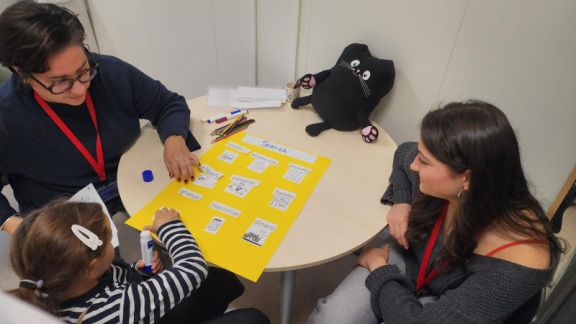By Helen Absalom and Carren Ward, English Language Acquisition Teachers and Multilingualism Specialists
The day started with all our parents arriving bright-eyed and bushy-tailed at 8:00 and making their way to our meeting room. There, after a quick coffee our grade 1 English Language Acquisition Teachers, Mrs Carren Ward and Ms Helen Absalom led a training session for the parents. In the training session, our intrepid parent-teachers received teacher packs which included a lesson plan and all the materials for that lesson. After the parent-teachers had examined the contents of their envelopes, Mrs Ward and Ms Helen explained the lesson plan and the activities in the lesson.
Speaking exclusively in the home language
They emphasised the importance of speaking exclusively in the home language, repeating the key vocabulary, taking their time and above all, having fun.

19 different languages in 19 different learning areas
After the training, parents proceeded to their teaching areas. We had 19 languages (Afrikaans, Arabic, Bengali, English, French, German, Hebrew, Hindi, Italian, Kannada, Marathi, Malayalam, Polish, Russian, Serbian, Spanish, Swedish, Tamil and Telugu) so we had 19 tiny teaching areas. It was a regular day, so the school and classrooms were full. We needed to get creative and use all the corners, nooks and crannies that we could find.
Key unit vocabulary
During the 30-minute lesson, parents and children played games with key unit vocabulary cards and pictures and then created a poster using the same materials. There was a lovely buzz of chatter in all the languages in all the mini classes and everyone was full of smiles and laughter (as well as learning, of course).




Cross-linguistic connections
Meanwhile, back in the classroom, children who had worked separately within their language groups but on the same activity, now excitedly shared the words they had learned in their home languages and made cross-linguistic connections.
What our students thought about this lesson
“It was fantastic! But can we do it for longer next time?”
“I think we need two lessons. One to learn the words and then another one where we teach the words in our languages to our friends.”
Since the lesson, the posters have been displayed in the classrooms and teachers refer to them regularly while working on the unit. We would like to thank all of you who helped. What a wonderfully rich linguistic tapestry we weave.
